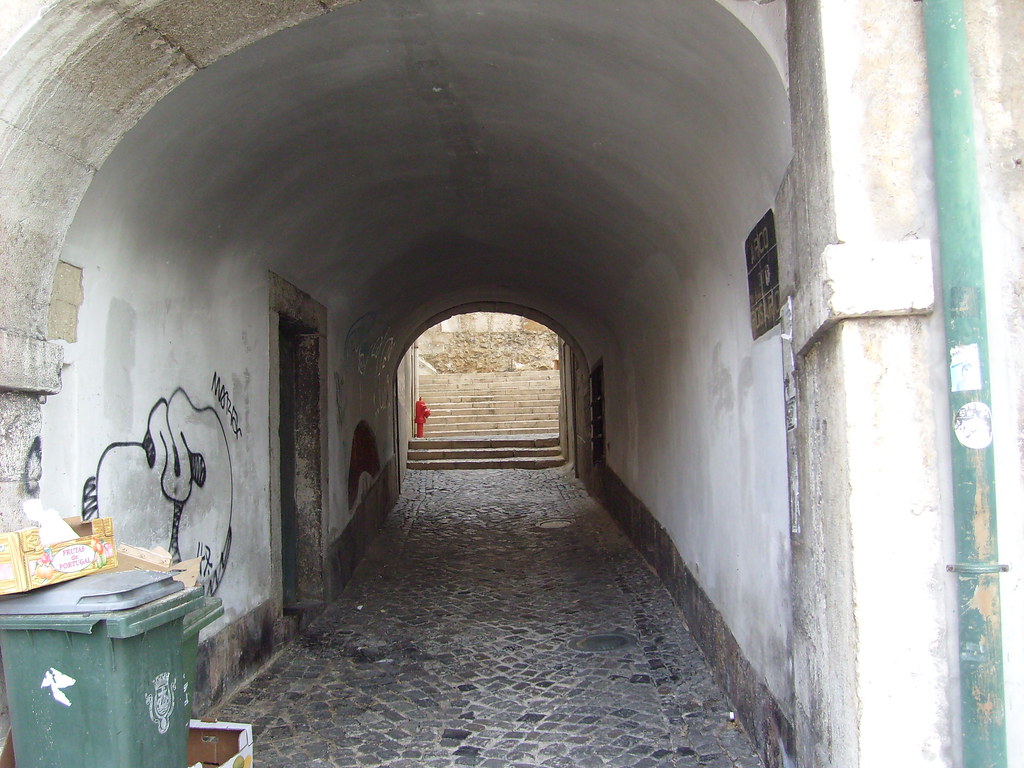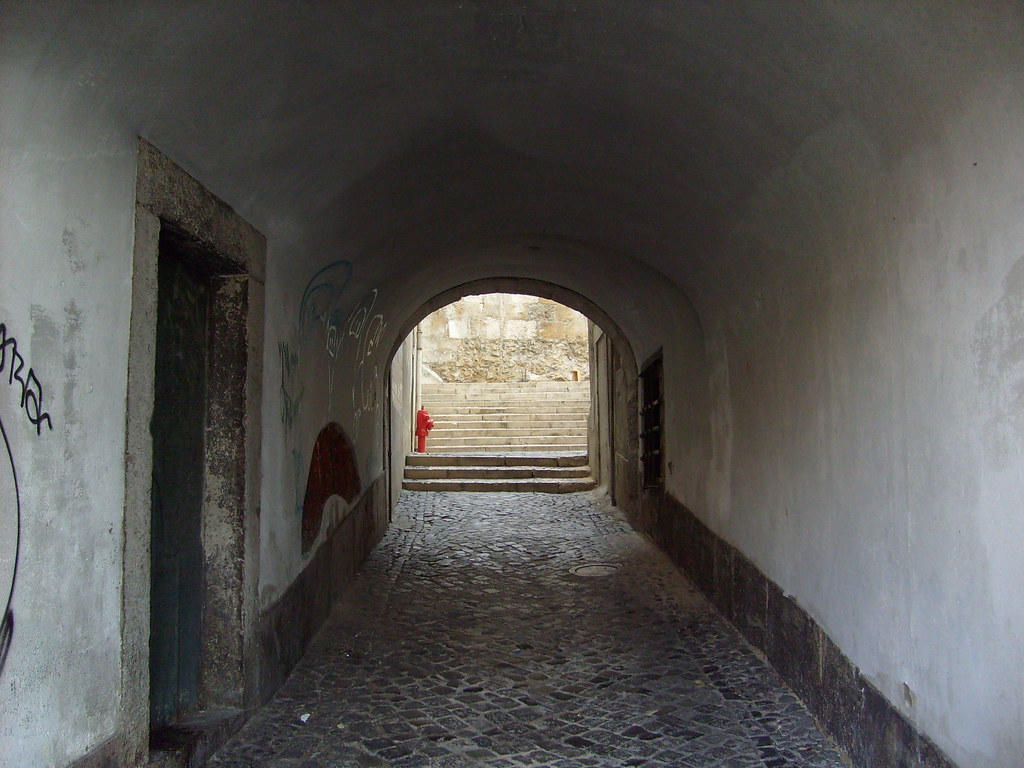
"Folding the corner from the fountain of EL-King, to the Terreiro do Trigo, entering the Arc of the Rosary and found the Jewish Quarter. The Jewish quarter of Alfama stood on the present site of the Jewish Quarter Street: the area of Alfama is attached to the wall on the side facing the sea to the tower of San Pedro in 1379 there was a synagogue close shortly afterwards sent by D. Fernando, for this is in place to disrupt the prayers in the church of San Pedro.
Next to some major cities there were almost always the Judarias, or the Moorish quarter, and separate enclosures for private housing of the Jews and Moors tolerated in society. Since the use in the average age left clear traces in Lisbon on behalf of two public Rights of access: the Jewish and Moorish quarter (name still remains in the street to the National Wheat) was finally within another haul of the wall, and so did the other the Judiaria Kingdom within the area bounded by walls.
It is here that was born in 1929 to the current House of Fado "Heart of Alfama" this house, formerly was known for the Tavern "Chico's deep pit" where, besides the eat traditional dishes at the same time is politically convivia. In fact it was here that the workers met to discuss and make anti-propaganda. There are testimonials from residents Alfama in themselves.
Today, "Heart of Alfama", typical restaurant, offers evenings of fado to customers who visit us, this is where the star is at the time that passes ... that the nights are unforgettable in coexistence between the flavors of traditional Portuguese food and good fortune." Tune Here to here a bit on typical fado music :)
Next to some major cities there were almost always the Judarias, or the Moorish quarter, and separate enclosures for private housing of the Jews and Moors tolerated in society. Since the use in the average age left clear traces in Lisbon on behalf of two public Rights of access: the Jewish and Moorish quarter (name still remains in the street to the National Wheat) was finally within another haul of the wall, and so did the other the Judiaria Kingdom within the area bounded by walls.
It is here that was born in 1929 to the current House of Fado "Heart of Alfama" this house, formerly was known for the Tavern "Chico's deep pit" where, besides the eat traditional dishes at the same time is politically convivia. In fact it was here that the workers met to discuss and make anti-propaganda. There are testimonials from residents Alfama in themselves.
Today, "Heart of Alfama", typical restaurant, offers evenings of fado to customers who visit us, this is where the star is at the time that passes ... that the nights are unforgettable in coexistence between the flavors of traditional Portuguese food and good fortune." Tune Here to here a bit on typical fado music :)
Old Quarter Description
"(Local Name: Alfama) Located on the southeastern slope of the hill crowned by Castelo de Sao Jorge is Alfama, Lisbon's oldest quarter, which sufferred only slight damage in the 1775 earthquake. Visitors will find the unique atmosphere prevailing in the streets and alleyways of far greater interest than individual buildings.
Some houses in this quarter still stand on foundations dating from the times of the West Goths, but the whole structure of the area was essentially shaped by the Arabs. Although no houses remain from this era, the confused arrangement of its maze of streets and alleyways does. The name Alfama is also derived from Arabian origins and probably evolved from the word al-Hama, the name of
Some houses in this quarter still stand on foundations dating from the times of the West Goths, but the whole structure of the area was essentially shaped by the Arabs. Although no houses remain from this era, the confused arrangement of its maze of streets and alleyways does. The name Alfama is also derived from Arabian origins and probably evolved from the word al-Hama, the name of
the thermal spring which once bubbled here.
Moors, Christians and Jews lived in the old quarter. Rua da Judiaria recalls one of its three former Jewish ghettos. Today it seems almost inconceivable that during the Middle Ages Alfama was once a respected, rich quarter where prosperous members of the bourgeoisie and aristocrats lived. From the 16th C. mainly fishermen, craftsmen, workers and sailors settled here, while in the 18th C. the area was temporarily regarded as a center of prostitution. Regarding higgledy piggledy Alfama the rational planning minister Pombal is supposed to have said that Lisbon could really do with a second earthquake.
Travel guides of the 19th C. paint a picture of an extremely gloomy, dirty and depressing area. Reference is made to the many cases of tuberculosis and the ever present danger of epidemics which arose as a result of unhealthy living conditions. Today the poorer classes continue to live here, mainly in houses in need of renovation. Insufficient heating, or a complete lack of it, and draughty walls in the small, closely built flats, where little sunlight penetrates, ensure poor living conditions, especially in winter. At present some of the houses in the inner city are being renovated as part of a redevelopment scheme.
To maintain the structure of the population that has evolved within the quarter, drastic rent increases are being avoided as much as possible. Even the inhabitants themselves pay attention to whoever becomes the next tenant of a flat which has become available.
This old quarter appears very picturesque to visitors in the summer. As the city of Lisbon is fully aware of Alfama's attraction to visitors, it gives financial support to the maintenance and improvement of the quarter's facades. Wandering through the labyrinth of winding alleyways, small archways and little flights of steps, many idyllic and picturesque corners are encountered.
Bright washing flaps in front of colorful house fronts, canaries sing from their cages hanging from windows and doors, numerous flower pots compensate for the lack of greenery in the streets. On warm days the shade offerred by the densely built houses explains the reasoning behind this style of construction.
Alfama's structure is such that few cars can enter there, emphasising the feeling of having been transported to a different time. Correspondingly, the atmosphere in the quarter is considerably defined by the different noises and smells. Life is lived for the most part on the street. The many tourists who stream through Alfama in the summer are tolerated in a serene and friendly manner.
In the evenings fado, the kind of music which was particularly popular in the 19th C., can be listened to in bars provided specially for tourists.
The route into Alfama leads via Rua Augusto Rosa/Rua do Limoeiro past the Sé Patriarchal and the Igreja de Santo António da Sé to the Santa Luzia viewpoint.
One of the "entrances" to the quarter, via the steps of Rua Norberto Araújo next to the Igreja de Santa Luzia, is located here. From the Tagus, a tour around the Largo do Terreiro do Trigo can begin through the Arco do Rosário."[*]
Moors, Christians and Jews lived in the old quarter. Rua da Judiaria recalls one of its three former Jewish ghettos. Today it seems almost inconceivable that during the Middle Ages Alfama was once a respected, rich quarter where prosperous members of the bourgeoisie and aristocrats lived. From the 16th C. mainly fishermen, craftsmen, workers and sailors settled here, while in the 18th C. the area was temporarily regarded as a center of prostitution. Regarding higgledy piggledy Alfama the rational planning minister Pombal is supposed to have said that Lisbon could really do with a second earthquake.
Travel guides of the 19th C. paint a picture of an extremely gloomy, dirty and depressing area. Reference is made to the many cases of tuberculosis and the ever present danger of epidemics which arose as a result of unhealthy living conditions. Today the poorer classes continue to live here, mainly in houses in need of renovation. Insufficient heating, or a complete lack of it, and draughty walls in the small, closely built flats, where little sunlight penetrates, ensure poor living conditions, especially in winter. At present some of the houses in the inner city are being renovated as part of a redevelopment scheme.
To maintain the structure of the population that has evolved within the quarter, drastic rent increases are being avoided as much as possible. Even the inhabitants themselves pay attention to whoever becomes the next tenant of a flat which has become available.
This old quarter appears very picturesque to visitors in the summer. As the city of Lisbon is fully aware of Alfama's attraction to visitors, it gives financial support to the maintenance and improvement of the quarter's facades. Wandering through the labyrinth of winding alleyways, small archways and little flights of steps, many idyllic and picturesque corners are encountered.
Bright washing flaps in front of colorful house fronts, canaries sing from their cages hanging from windows and doors, numerous flower pots compensate for the lack of greenery in the streets. On warm days the shade offerred by the densely built houses explains the reasoning behind this style of construction.
Alfama's structure is such that few cars can enter there, emphasising the feeling of having been transported to a different time. Correspondingly, the atmosphere in the quarter is considerably defined by the different noises and smells. Life is lived for the most part on the street. The many tourists who stream through Alfama in the summer are tolerated in a serene and friendly manner.
In the evenings fado, the kind of music which was particularly popular in the 19th C., can be listened to in bars provided specially for tourists.
The route into Alfama leads via Rua Augusto Rosa/Rua do Limoeiro past the Sé Patriarchal and the Igreja de Santo António da Sé to the Santa Luzia viewpoint.
One of the "entrances" to the quarter, via the steps of Rua Norberto Araújo next to the Igreja de Santa Luzia, is located here. From the Tagus, a tour around the Largo do Terreiro do Trigo can begin through the Arco do Rosário."[*]








4 comments:
Alfama, Alfama ... I love Alfama. This is Alfama Xtra Large! LOL
Awesome pictures and thanks for the history and description ... very nice!!
Great information!! Thanks so much. Great pictures and Fado. MB
Great post, Mary Jo! Wonderful music! I love to hear FADO!
Yesterday I received the "Blogging Friends Forever" Award for my photos and overall enthusiasm for life, from Ken Mac, from Greenwich Village Daily Photo.
According to the rules I can now award this honor to 5 other bloggers of my choice. I have chosen your blog as I really like your photos and also for your amazing issues and information!
Please visit my blog and you will see your name among the 5 other awardees. Then it will be your turn - if you like so - to give the award yourself to 5 other bloggers of your choice, according to the rules you will find indicated there!
Greetings from Leaves of Grass!
Thank You for the information...
Nice photos...
Post a Comment